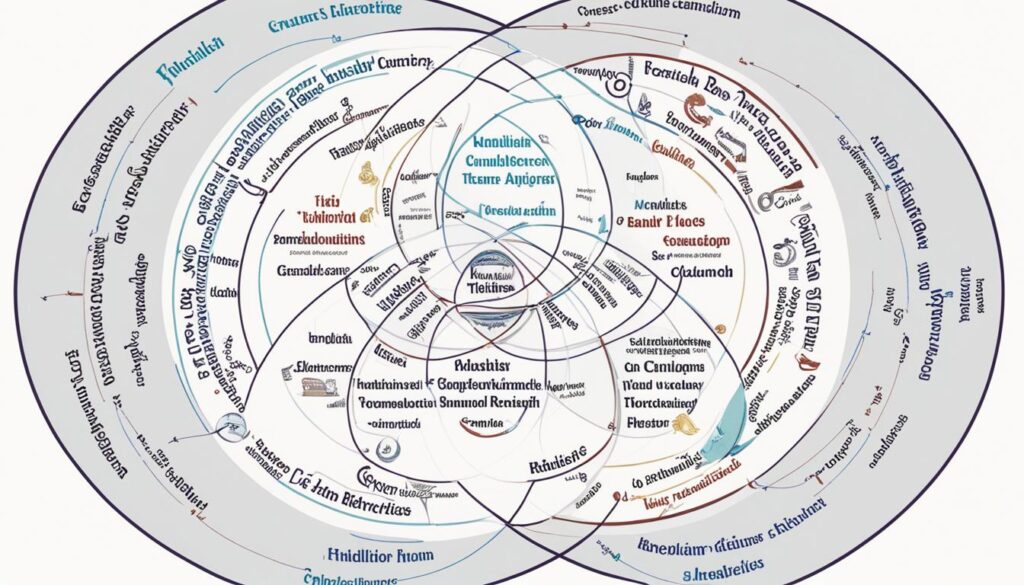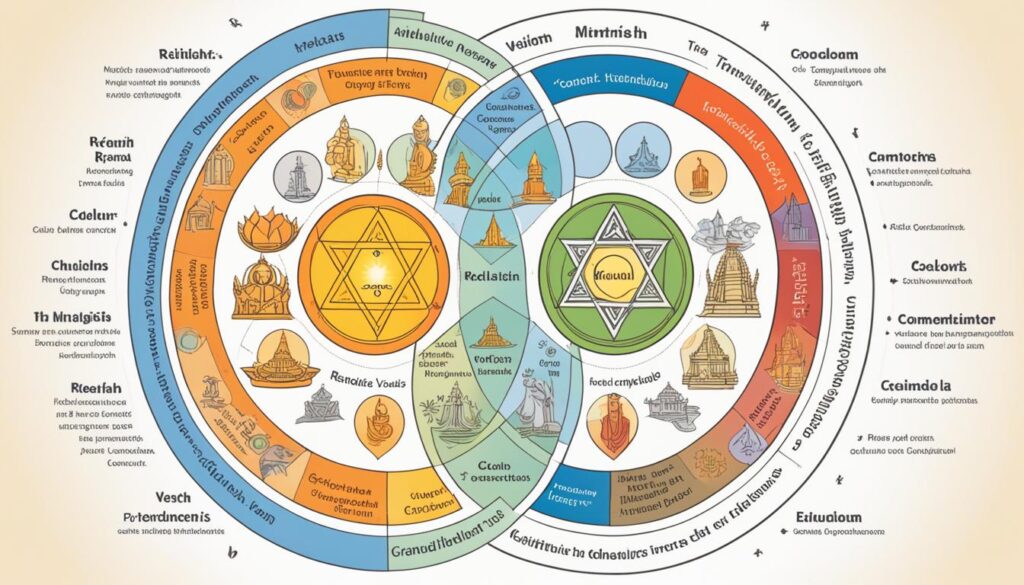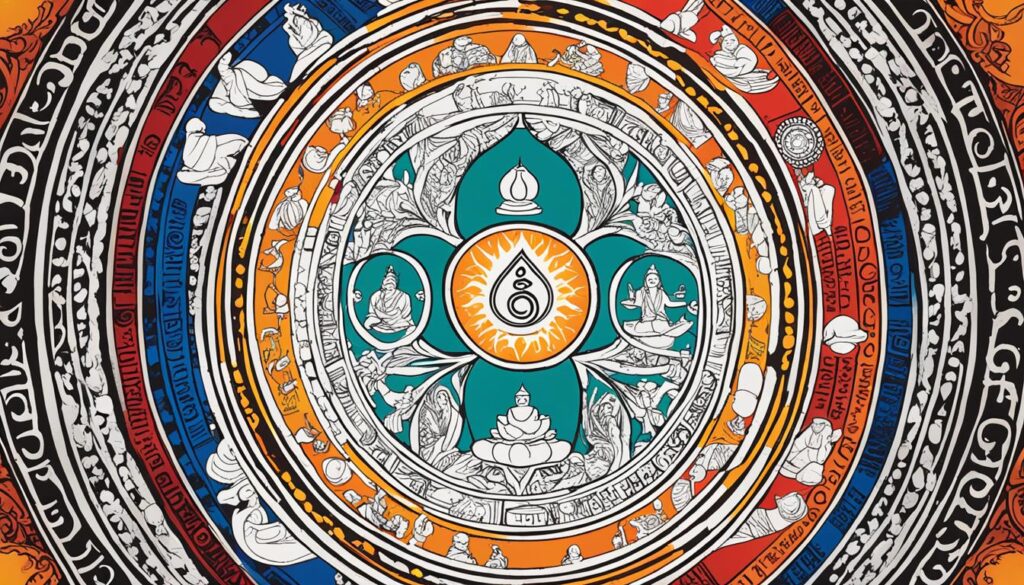Have you ever wondered about the differences between Hinduism and Buddhism? Are you curious about the unique aspects of each religion that sets them apart? Prepare to be enlightened as we delve into the spiritual contours of Eastern wisdom and explore the distinctions between Hinduism and Buddhism. But first, let’s start by examining a Venn diagram that visually represents these differences.
Key Takeaways:
- Hinduism and Buddhism are two of the oldest religions in the world.
- While they share some similarities, they also have distinct differences.
- A Venn diagram can help us visualize the overlapping beliefs and practices, as well as the unique aspects of each religion.
- Hinduism aims to attain moksha, while Buddhism seeks nirvana or enlightenment.
- Both religions have their own worship rituals and places of worship but incorporate different approaches.
Key Beliefs and Practices in Hinduism and Buddhism
Hinduism and Buddhism are two ancient religions that have shaped the spiritual paths of millions around the world. While they share some similarities, such as promoting self-discovery and personal growth, these religions also differ in their core beliefs and practices. Let’s explore the key aspects that distinguish Hinduism and Buddhism.
Hinduism: Attaining Moksha
In Hinduism, the ultimate goal is to attain moksha, which signifies liberation from the cycle of birth and rebirth, known as samsara. This spiritual liberation is believed to be achieved through a combination of good deeds, devotion to deities, and gaining spiritual knowledge. Hindus strive to follow the path of righteousness, righteousness, or dharma, and believe in reincarnation, where the soul transmigrates into a new body after death. The concept of karma plays a central role, as it determines the quality of life in subsequent existences.
Buddhism: Journey to Nirvana
In Buddhism, the focus is on reaching nirvana, a state of enlightenment and liberation from suffering. The fundamental teachings of Buddhism are encapsulated in the Noble Eightfold Path, which consists of right understanding, right thought, right speech, right action, right livelihood, right effort, right mindfulness, and right concentration. By following this path, practicing meditation, and cultivating mindfulness, individuals can transcend suffering and break free from the cycle of rebirth.
While Hinduism and Buddhism both emphasize the importance of moderation, compassion, and self-discipline, they have different approaches to achieving spiritual enlightenment. Hinduism places emphasis on devotion to deities, rituals, and religious scriptures, while Buddhism focuses on the individual’s inner journey and self-realization.
| Hinduism | Buddhism |
|---|---|
| Goal: Attaining Moksha | Goal: Journey to Nirvana |
| Emphasizes devotion, good deeds, and knowledge | Emphasizes meditation, mindfulness, and the Noble Eightfold Path |
| Belief in reincarnation and karma | Belief in breaking the cycle of rebirth through enlightenment |
| Idol worship and rituals | Fewer rituals, focus on meditation and mindfulness |

While Hinduism and Buddhism have their unique beliefs and practices, they both offer valuable wisdom and guidance for spiritual seekers. Exploring the differences and similarities through a Venn diagram can help us appreciate the richness and diversity of these ancient traditions, ultimately leading to a deeper understanding of ourselves and the world around us.
Worship and Rituals in Hinduism and Buddhism
The places of worship in Hinduism are known as temples, where devotees gather to offer prayers and perform rituals. These temples are seen as sacred spaces, where individuals connect with the divine and seek spiritual guidance. Hindu worship often involves elaborate ceremonies conducted by priests, including the chanting of hymns, the offering of flowers and fruits, and the lighting of candles and incense.
In contrast, Buddhism emphasizes simplicity and mindfulness in its worship practices. The primary places of worship in Buddhism are Buddhist monasteries, shrines, and temples. These serene spaces serve as a refuge for Buddhist practitioners to meditate, reflect, and cultivate inner peace.

Both Hinduism and Buddhism have their own set of rituals and ceremonies designed to honor their deities and seek spiritual enlightenment. In Hinduism, rituals play a vital role in connecting individuals with the divine and purifying their souls. These rituals often involve offerings to deities, such as food, flowers, and water, as well as the recitation of sacred texts.
Buddhism, on the other hand, focuses on meditation and mindfulness as means of attaining spiritual awakening. Buddhist rituals often involve the practice of mindfulness, chanting of mantras, and the offering of candles and incense to Buddha statues. These rituals serve as a way to cultivate inner peace, wisdom, and compassion.
While Hinduism has a rich tradition of idol worship, where devotees offer their prayers and seek the blessings of their deities through statues and images, Buddhism also incorporates the use of statues and images as objects of veneration. These symbols serve as a reminder of the Buddha’s teachings and inspire practitioners to cultivate virtues such as compassion, loving-kindness, and wisdom.
Through worship and rituals, individuals in both Hinduism and Buddhism seek to deepen their spiritual connection and cultivate qualities that lead to enlightenment. Whether through elaborate ceremonies or quiet moments of meditation, these practices serve as a pathway to a higher understanding of oneself and the universe.
Historical Origins and Cultural Influence
Hinduism and Buddhism have deeply rooted historical origins and have had a profound cultural influence on the regions where they are practiced. Let’s explore their fascinating journeys and impact.
Hinduism: The Oldest Religion
Hinduism, considered the oldest religion in the world, traces its roots back thousands of years. It emerged in the Indian subcontinent and has since become an integral part of the region’s culture and traditions. Hinduism embodies a diverse range of beliefs, rituals, and practices, making it a rich tapestry of spirituality.
Over the centuries, Hinduism has shaped various aspects of Indian society, including art, architecture, literature, and social structures. From ancient temples to vibrant festivals, Hinduism permeates every aspect of life, contributing to the vibrant and diverse cultural landscape of India and beyond.
Buddhism: A Spiritual Offshoot
Buddhism, a spiritual offshoot of Hinduism, originated in the 6th century BCE under the guidance of Gautama Buddha. It was born out of a quest for enlightenment and a desire to alleviate human suffering. The teachings of Buddhism spread rapidly, reaching various parts of Asia, including countries like Japan, Cambodia, Sri Lanka, and Myanmar.
Similar to Hinduism, Buddhism has left indelible imprints on the culture and traditions of the regions it has touched. Buddhist influences can be seen in the intricate architecture of temples, the serene beauty of Buddhist art, and the profound impact of Buddhist philosophy on literature and social structures.

Both Hinduism and Buddhism have played vital roles in shaping the spiritual, intellectual, and artistic dimensions of the societies in which they have flourished. Their historical origins and cultural influences continue to resonate in the collective consciousness of people across the world.
Conclusion
Exploring the differences between Hinduism and Buddhism through a Venn diagram allows us to appreciate the unique aspects of each religion while also recognizing the commonalities that bind them together. By understanding their beliefs, practices, worship, historical origins, and cultural influence, you can gain a deeper appreciation for the spiritual wisdom they offer.
Whether you resonate more with Hinduism or Buddhism, both provide valuable insights for personal and societal harmony. These ancient traditions address modern challenges through mindfulness, compassion, and the pursuit of enlightenment. They offer guidance on finding inner peace, cultivating empathy, and navigating the complexities of life.
The Venn diagram serves as a powerful tool in visualizing the overlapping ideals and teachings of Hinduism and Buddhism. It allows us to observe the shared concepts such as karma, dharma, and the cycle of birth and rebirth. Furthermore, it highlights the distinct methods each religion employs to achieve spiritual goals, whether it is through devotion, knowledge, or following the Noble Eightfold Path.
As you delve into the depths of these two religions, you will discover a rich tapestry of history, philosophy, and cultural heritage. Hinduism, with its ancient roots and cultural influence in India and beyond, has shaped traditions, art forms, and societal structures. Buddhism, born from Hinduism and propagated across Asia, has sparked profound transformations in various cultures, leaving its indelible mark on literature, philosophy, and artistic expression.

